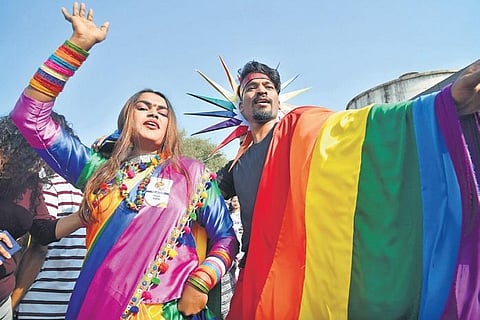

June is observed as Pride Month in many countries, including India, in commemoration of the Stonewall riots of 1969. These occasions provide an appropriate socio-political platform for members of the sexual minority to gather, celebrate and voice their demands that need to reach the masses and the policymakers. Pride Day is a platform for lived narratives and voices of their struggle.
The LGBTQIA+ (lesbian, gay, bisexual, transgender, queer, intersex, asexual) movement is a pretty recent phenomenon in India’s history, culminating in the historic decriminalisation of Section 377 that gave homosexuality a criminal status.
The dreary law which was set in colonial ink had finally reached its expiry date and millions of closeted and out-in-the-open members felt a collective loosening of the noose around their necks. Now they could breathe and feel alive again—at least in the eyes of the judiciary. But the social and moral compasses of society were still vehemently pointing their incriminating and disparaging fingers at them. They were like pardoned convicts: freed by the law but castigated by their society, to whom they were still reprobates.
Mentions of homosexual dimensions of life form a part of essential Hindu canonical works like the Rig Veda. There are chapters on homoerotic behaviour in Vatsyayana’s Kamasutra and Kautilya’s Arthasastra. There are portrayals of homosexual behaviour in the carvings of the famous Khajuraho temples.
Indian mythology is rife with such stories. Arjuna—the hero of the Mahabharata—was transformed into Brihannala due to Urvashi’s curse. Shikhandi, the sibling of Draupadi, was a eunuch who fought in the Battle of Kurukshetra and was instrumental in bringing down the mighty warrior Bhishma. This swung the battle decisively in the favour of the Pandavas, thereby ensuring the reign of truth and justice. Some sources state that there were courtiers in the abode of Lord Indra called “kinnars”, who were eunuchs and considered to be adept at the performing arts.
Such narratives are portrayed on various historical monuments and temples, which are a matter of study interest and candid photography. Yet, this is stigmatised by society when it comes to sexuality.
Along came the British Raj to India. Section 377 was drafted by Thomas Babington Macaulay in 1862. Macaulay was the head of the Law Commission and was installing anti-sodomy laws that criminalised any form of sexual activity that was “against the order of nature”, punishable by law and carried a life sentence. During the 157 years of Section 377, the LGBTQIA+ community in India has suffered terribly. Clearly, the colonial hangover is still furthering our harsh and unfair treatment towards this community, which is in stark contrast to our cultural and spiritual ethos.
Even in this era of scientific pragmatism and logical empiricism, we see society’s refusal to acknowledge the LGBTQIA+ community on par with the “heteronormals” and it continues to dehumanise and ostracise them like they are a bunch of moral and sexual outcasts.
Even after the decriminalisation of Section 377, the paths of the members of this community are beset with roadblocks. Problems of sexual abuse, familial dysfunction, peer rejection, juvenile delinquency, societal taboo, sexual disharmony, unsafe sexual behaviour and drug abuse are rampant amongst this community while growing up. The adult life doesn’t offer any soothing escape from the harsh adolescence either. Unrecognised marital status, hazards of adoption, housing, property inheritance, difficulty finding regular employment, discrimination and harassment at the workplace, etc., are recurring and diabolical features of their daily lives. The mental and physical consequences of these prejudices take a gargantuan toll on their lives. Ageism and sexual discrimination are other hassles.
Increasing evidence points out that depression, suicides, self-harm and substance abuse are twice as common in LGBTQIA+ individuals compared to heterosexual people.
And this is without taking into account the familial disruption and caregiver stress that is trapped under the rubble of such issues. Even healthcare professionals and institutes show alarmingly high rates of homophobic bias and discriminatory attitudes towards these individuals in line with the heteronormativity principle that unfortunately guides their viewpoints. Mental health issues, already a matter of stigma in our country, get further brushed under the carpet vis-à-vis members of the LGBTQIA+ community and equated with their general “suffering”. The laws and policies related to mental health and suicide prevention rarely consider their narratives. Of specific concern is HIV and other sexually transmitted illnesses, injectable drug abuse, and the risk of sexual violence and sexual dysfunctions.
LGBTQIA+ individuals tend to remain isolated within their community as that gives them security, comfort and acceptance. The social ostracisation and marginalisation leads to “minority stress”, and this has adverse psychological and social effects that can be transgenerational.
Emotional health does not exist in a vacuum. Meaningful participation from all sectors of society, sensitisation of healthcare professionals to their unmet needs, inclusion of their voices in policies, and a holistic “welcome” to their identity among us are the needs of the hour. That bridges the hierarchical gap between this “othered” community and society, therefore improving their quality of life and living.
Coming from the civilisation that gregariously proclaims “Ekoham bahusyami” (One to many and many to one), it should be our true spirit in thought and action.
Dr Debanjan Banerjee
Consultant Psychiatrist, APOLLO Multispecialty Hospitals, Kolkata
Dr Mayank Rai
Assistant Professor, Shridev Suman Subharti Medical College, Dehradun